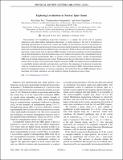| dc.contributor.author | Ramanathan, Chandrasekhar | |
| dc.contributor.author | Wei, Xuan | |
| dc.contributor.author | Cappellaro, Paola | |
| dc.date.accessioned | 2018-04-19T17:20:04Z | |
| dc.date.available | 2018-04-19T17:20:04Z | |
| dc.date.issued | 2018-02 | |
| dc.date.submitted | 2017-07 | |
| dc.identifier.issn | 0031-9007 | |
| dc.identifier.issn | 1079-7114 | |
| dc.identifier.uri | http://hdl.handle.net/1721.1/114797 | |
| dc.description.abstract | Characterizing out-of-equilibrium many-body dynamics is a complex but crucial task for quantum applications and understanding fundamental phenomena. A central question is the role of localization in quenching thermalization in many-body systems and whether such localization survives in the presence of interactions. Probing this question in real systems necessitates the development of an experimentally measurable metric that can distinguish between different types of localization. While it is known that the localized phase of interacting systems [many-body localization (MBL)] exhibits a long-time logarithmic growth in entanglement entropy that distinguishes it from the noninteracting case of Anderson localization (AL), entanglement entropy is difficult to measure experimentally. Here, we present a novel correlation metric, capable of distinguishing MBL from AL in high-temperature spin systems. We demonstrate the use of this metric to detect localization in a natural solid-state spin system using nuclear magnetic resonance (NMR). We engineer the natural Hamiltonian to controllably introduce disorder and interactions, and observe the emergence of localization. In particular, while our correlation metric saturates for AL, it slowly keeps increasing for MBL, demonstrating analogous features to entanglement entropy, as we show in simulations. Our results show that our NMR techniques, akin to measuring out-of-time correlations, are well suited for studying localization in spin systems. | en_US |
| dc.description.sponsorship | United States. Air Force Office of Scientific Research (Grant FA9550-12-1-0292) | en_US |
| dc.description.sponsorship | United States. Office of Naval Research (Grant N00014-14-1-0804) | en_US |
| dc.description.sponsorship | National Science Foundation (U.S.) (Grant PHY0551153) | en_US |
| dc.description.sponsorship | National Science Foundation (U.S.) (Grant CHE1410504) | en_US |
| dc.publisher | American Physical Society | en_US |
| dc.relation.isversionof | http://dx.doi.org/10.1103/PhysRevLett.120.070501 | en_US |
| dc.rights | Article is made available in accordance with the publisher's policy and may be subject to US copyright law. Please refer to the publisher's site for terms of use. | en_US |
| dc.source | American Physical Society | en_US |
| dc.title | Exploring Localization in Nuclear Spin Chains | en_US |
| dc.type | Article | en_US |
| dc.identifier.citation | Wei, Ken Xuan et al. "Exploring Localization in Nuclear Spin Chains." Physical Review Letters 120, 7 (February 2018): 070501 © 2018 American Physical Society | en_US |
| dc.contributor.department | Massachusetts Institute of Technology. Department of Physics | en_US |
| dc.contributor.department | Massachusetts Institute of Technology. Laboratory for Nuclear Science | en_US |
| dc.contributor.department | Massachusetts Institute of Technology. Research Laboratory of Electronics | en_US |
| dc.contributor.mitauthor | Wei, Xuan | |
| dc.contributor.mitauthor | Cappellaro, Paola | |
| dc.relation.journal | Physical Review Letters | en_US |
| dc.eprint.version | Final published version | en_US |
| dc.type.uri | http://purl.org/eprint/type/JournalArticle | en_US |
| eprint.status | http://purl.org/eprint/status/PeerReviewed | en_US |
| dc.date.updated | 2018-02-13T18:00:25Z | |
| dc.language.rfc3066 | en | |
| dc.rights.holder | American Physical Society | |
| dspace.orderedauthors | Wei, Ken Xuan; Ramanathan, Chandrasekhar; Cappellaro, Paola | en_US |
| dspace.embargo.terms | N | en_US |
| dc.identifier.orcid | https://orcid.org/0000-0003-2627-7131 | |
| dc.identifier.orcid | https://orcid.org/0000-0003-3207-594X | |
| mit.license | PUBLISHER_POLICY | en_US |
